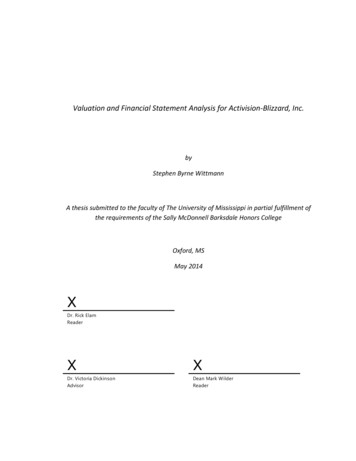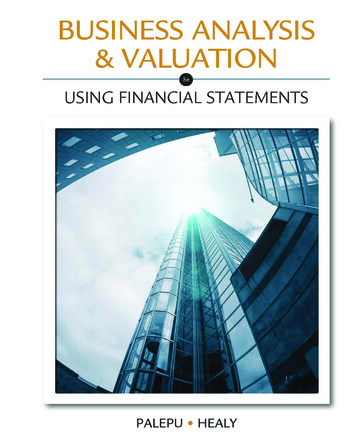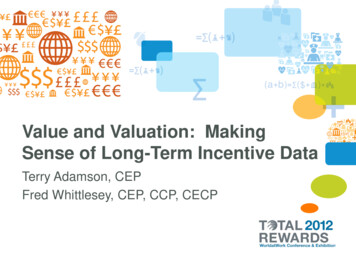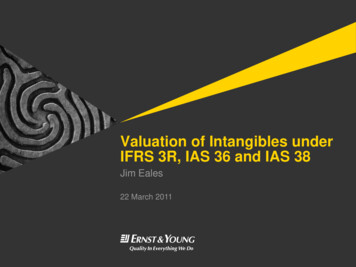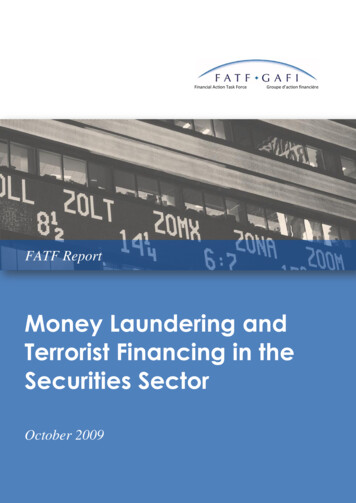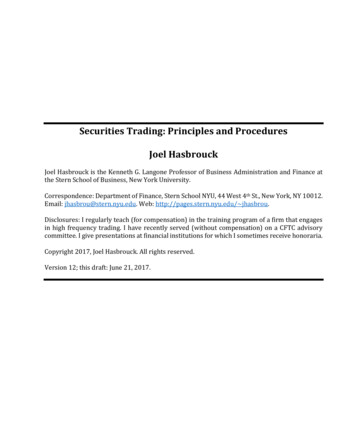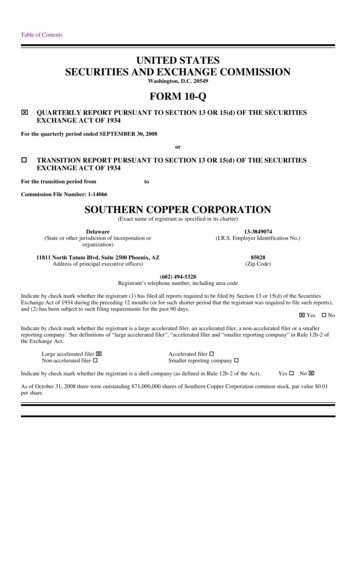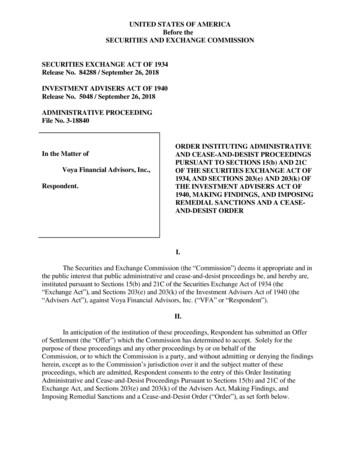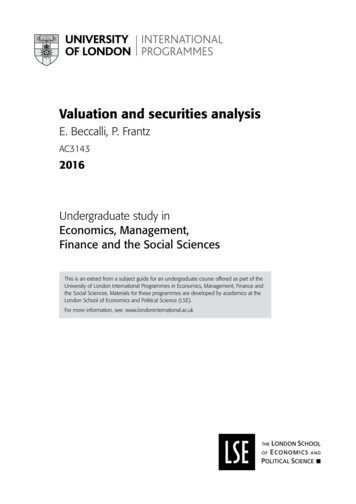
Transcription
Valuation and securities analysisE. Beccalli, P. FrantzAC31432016Undergraduate study inEconomics, Management,Finance and the Social oninternational.ac.ukwww.londoninternational.ac.uk
This guide was prepared for the University of London International Programmes by:E. Beccalli, Visiting Senior Fellow in Accounting, The London School of Economics and PoliticalScience.P. Frantz, Lecturer in Accounting and Finance, The London School of Economics andPolitical Science.This is one of a series of subject guides published by the University. We regret that dueto pressure of work the authors are unable to enter into any correspondence relating to,or arising from, the guide. If you have any comments on this subject guide, favourable orunfavourable, please use the form at the back of this guide.University of London International ProgrammesPublications OfficeStewart House32 Russell SquareLondon WC1B 5DNUnited Kingdomwww.londoninternational.ac.ukPublished by: University of London University of London 2013Reprinted with minor revisions 2016The University of London asserts copyright over all material in this subject guide except whereotherwise indicated. All rights reserved. No part of this work may be reproduced in any form,or by any means, without permission in writing from the publisher. We make every effort torespect copyright. If you think we have inadvertently used your copyright material, please letus know.
ContentsContentsChapter 1: Introduction. 1Route map to the guide. 1Introduction to the subject guide. 2Syllabus. 2Aims of the course. 4Learning outcomes for the course. 4Overview of learning resources. 4Examination advice. 10List of abbreviations. 10Chapter 2: Introduction to the Ryanair case study. 13Aim of the chapter . 13Learning outcome. 13Ryanair. 13Part 1: The framework for analysis. 19Chapter 3: The analysis framework and financial statements. 21Introduction. 21Aim. 21Learning outcomes. 21Essential reading. 22Works cited. 22Capital markets and the role of valuation and securities analysis. 22Introduction to stylised financial statements. 26Accounting relations governing the stylised financial statements. 35Overview of chapter. 38Key terms . 39A reminder of your learning outcomes. 40Test your knowledge and understanding. 40Chapter 4: Financial analysis: performance evaluation. 41Introduction. 41Aim. 41Learning outcomes. 41Essential reading. 42Further reading. 42Works cited. 42Accounting-based measures of performance. 42Market-based measures of performance. 47Accounting-based versus market-based performance measures. 49Present value of abnormal earnings. 50Accounting choices, accounting-based performance measures and valuation. 51Overview of the chapter. 52Key terms. 53A reminder of your learning outcomes. 53Test your knowledge and understanding. 53Appendix. 54i
AC3143 Valuation and securities analysisChapter 5: Financial analysis: the determinants of performance. 55Introduction. 55Aim. 56Learning outcomes. 56Essential reading. 56Further reading. 56Financial analysis: time-series and cross-sectional analysis. 56Business profitability (RNOA). 57Abnormal (residual) operating income (AOI). 61Link between business and bottom-line profitability. 62Determinants of business profitability. 64Business profitability and free cash flows. 67Overview of chapter . 67Key terms. 68A reminder of your learning outcomes. 69Test your knowledge and understanding. 69Chapter 6: Accounting and strategy analysis. 71Introduction. 71Aim. 71Learning outcomes. 71Essential reading. 72Works cited. 72Strategy analysis. 72Institutional features of financial reporting. 78Accounting analysis. 81Overview of chapter. 84Key terms. 85A reminder of your learning outcomes. 85Test your knowledge and understanding. 85Part 2: Securities valuation. 87Chapter 7: Prospective performance evaluation and valuation. 89Introduction. 89Aim. 89Learning outcomes. 90Essential reading. 90Further reading. 90Works cited. 90Forecasting: simple forecasting and full-information forecasting. 90Simple forecasting techniques. 91Applicability of simple forecasting for valuation. 101Full-information forecasting. 101Chapter summary. 109Key terms. 110A reminder of your learning outcomes. 111Test your knowledge and understanding. 111Chapter 8: Securities valuation. 113Introduction. 113Aim . 114Learning outcomes. 114Essential reading. 114ii
ContentsFurther reading. 115Works cited. 115Discounted cash flow method. 115Dividend discount method and the discounted cash flow to equity method. 123Abnormal earnings method. 126Abnormal operating income method. 131Advantages and limits of AOI and EVA methods. 134Comparison of methods: empirical evidence. 134Overview of chapter. 138Key terms. 139A reminder of your learning outcomes. 140Test your knowledge and understanding. 140Chapter 9: Implications for price-to-earnings and price-to-book ratios. 143Introduction. 143Aim . 144Learning outcomes. 144Essential reading. 144Further reading. 144Works cited. 144Drivers of price-to-book (PB) ratios in efficient markets. 145Drivers of price-to-earnings (PE) ratios in efficient markets. 147Implications of PE and PB ratios in efficient markets for currentand future performance. 149Joint distribution of PE and PB ratios. 150Implications of strategic taxonomy for PE and PB ratios in efficient markets. 151Valuation using the ‘method of comparables’. 153Overview of chapter. 155Key terms. 156A reminder of your learning outcomes. 156Test your knowledge and understanding. 157Chapter 10: Financial information and stock prices. 159Introduction. 159Aim. 159Learning outcomes. 159Essential reading. 160Further reading. 160Works cited. 160Usefulness of earnings to investors: the empirical evidence fromcapital markets research. 161Methodological issues. 161Empirical evidence. 162Earnings response coefficients. 164Competing hypotheses to explain the earnings response conundrum. 166Fundamental information analysis and stock prices. 168The interpretation of fundamentals by the analysts’ community. 169Methodological issues. 171Empirical evidence on fundamentals. 172Overview of chapter. 174Key terms. 175A reminder of your learning outcomes. 175Test your knowledge and understanding. 175iii
AC3143 Valuation and securities analysisChapter 11: Applications. 177Introduction. 177Aim. 177Learning outcomes. 178Essential reading. 178Further reading. 178Works cited.
AC3143 Valuation and securities analysis is a 300 course offered on the Economics, Management, Finance and the Social Sciences (EMFSS) suite of programmes. It provides insights and understanding of security analysis and valuation from both theoretical and empirical perspectives. It is ai


